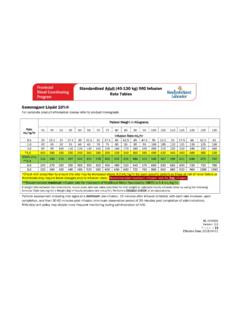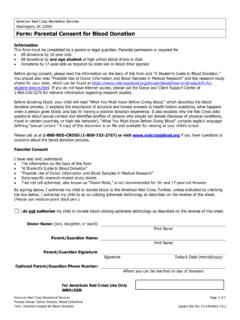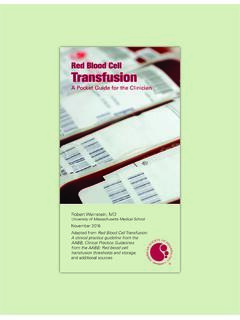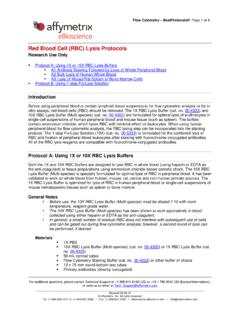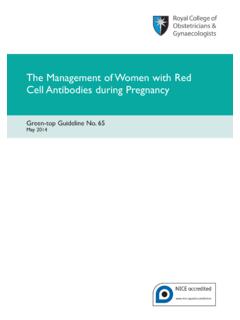Transcription of NL 2012-033 SOP for Preparation of Red Cell Suspensions final
1 STANDARD OPERATING PROCEDURE FOR Preparation OF red cell Suspensions Provincial Blood Coordinating Program _____ This document may be incorporated into each Regional Policy/Procedure Manual. NL2012-033 Version: Effective Date: 2012-01-30 Page 2 of 6 Standard Operating Procedure for Preparation of red cell Suspensions TITLE: STANDARD OPERATING PROCEDURE FOR Preparation OF red cell Suspensions Principle A red cell suspension is a common reagent used for many serologic procedures. red cell Suspensions provide the appropriate serum to cell ratio to allow for grading and interpretation of tests results.
2 Scope and Related Policies A 3-5% red cell suspension is used for the following tube examination procedures: ABO and Rh typing Direct antiglobulin test and auto control Donor unit compatibility (crossmatch) red cell phenotyping A red cell suspension is used for the following MTS test methods: Direct Antiglobulin Test Donor unit compatibility (crossmatch) Indirect Antiglobulin Test Identification Panel Test cells For best results red cell Suspensions should be used for testing on the day of Preparation . Information on the specimen used for testing and the information on the requisition/worksheet must be identical.
3 Specimens EDTA anticoagulated whole blood Cord blood collected in a plain tube Provincial Blood Coordinating Program _____ This document may be incorporated into each Regional Policy/Procedure Manual. NL2012-033 Version: Effective Date: 2012-01-30 Page 3 of 6 Standard Operating Procedure for Preparation of red cell Suspensions Materials Reagents: Isotonic saline MTS Diluent 2 Supplies: Test tubes (10x75mm) (12x75) Transfer pipettes Test tube rack Equipment: Serological centrifuge MTS Pipettor (s) MTS Diluent Dispenser Quality Control Visually compare the 3-5% red cell suspension to commercially prepared red cell suspension to ensure the appropriate strength has been acheived Mix the red cell suspension immediately before performing the serological procedure.
4 MTS Diluent 2 must be visually inspected on each day of use for turbidity, discoloration or show any signs of bacterial contamination. Daily Quality Control should consist of known positive and negative red cells diluted with each lot of MTS Diluent 2 and tested with the ID-Micro Typing System test being used. Provincial Blood Coordinating Program _____ This document may be incorporated into each Regional Policy/Procedure Manual. NL2012-033 Version: Effective Date: 2012-01-30 Page 4 of 6 Standard Operating Procedure for Preparation of red cell Suspensions Process Flowchart N/A Procedure Preparing a 3-5% red cell Suspension Label a tube with the patient identifier or donor unit number.
5 Add 2 drops of whole blood or 1 drop of packed cells into the appropriate labelled tube. Add to ml of saline to the labelled tube to produce a 3-5% red cell suspension. Mix to re-suspend. Compare the red cell suspension to a commercial 3% suspension ( reverse grouping cells ) if necessary, to ensure the appropriate strength has been achieved. Adjust to a 3-5% suspension by adding saline or centrifuging to remove saline. Mix the red cell suspension immediately before performing the serological procedure. Preparing washed 3-5% red cell Suspension Label a tube with the patient identifier or donor unit number.
6 Add 2 drops of whole blood or 1 drop of packed cells into a labelled test tube. Fill test tube full with saline to re-suspend the cells . Avoid contamination of tubes when dispensing saline into several tubes. Centrifuge the tube to obtain clear supernatant and a defined red cell button. (Speed and time as recommended by manufacturer s directions). Decant the supernatant. Following the removal of supernatant, gently re-suspend the red cell button. If more than one wash is required repeat steps through After the last wash, gently re-suspend the red cells with saline to a 3-5% red cell suspension. Compare the red cell suspension to a commercial 3% suspension if necessary, to ensure the appropriate strength has been achieved.
7 Adjust to a 3-5% suspension by adding saline or centrifuging to removing saline. Mix the red cell suspension immediately before performing the serological procedure. Provincial Blood Coordinating Program _____ This document may be incorporated into each Regional Policy/Procedure Manual. NL2012-033 Version: Effective Date: 2012-01-30 Page 5 of 6 Standard Operating Procedure for Preparation of red cell Suspensions Preparing a red cell Suspension from packed red cells Label a tube with the patient identifier or donor unit number. Add ml of MTS Diluent 2 to the labelled tube. Add 10 l packed red cells into the appropriate labelled tube.
8 Mix to re-suspend. Preparing a 3-5% red cell Suspension from a cell suspension Label a tube with the patient identifier or donor unit number. Mix the cell suspension. Add 500 l of the red cell suspension to the labelled tube. Centrifuge and decant the supernatant. Add 150 l of MTS Diluent 2 to the labelled tube. Mix to re-suspend. Compare to a commercial 3% reagent red cell suspension if necessary, to ensure the appropriate strength has been achieved. Preparing a red cell Suspension from a 3-5% cell suspension Label a tube with the patient identifier or donor unit number. Mix the 3-5% cell suspension.
9 Add 50 l of the 3-5% red cell suspension to the labelled tube. Centrifuge and decant supernatant. Add 150 l MTS Diluent 2 to the labelled tube. Mix to re-suspend. NOTE: Other methods recommended by the manufacturer can be used to prepare a red cell suspension depending on which pipettes are available. Reporting N/A Procedural Notes Variations in red cell concentration can markedly affect the sensitivity of tests results. If red cell Suspensions are too concentrated, it may mask weak agglutination. When red cell Suspensions are too low in concentration, they become difficult to visualize, and in extreme cases, a weak positive can fail to be detected.
10 Provincial Blood Coordinating Program _____ This document may be incorporated into each Regional Policy/Procedure Manual. NL2012-033 Version: Effective Date: 2012-01-30 Page 6 of 6 Standard Operating Procedure for Preparation of red cell Suspensions Red blood cell Suspensions prepared from cord blood specimen require a minimum of 3 washes. False positives or false negatives test results may occur from Bacterial or chemical contamination of test materials. Improper centrifugation. Improper storage of material. If using an MTS Dispenser, follow cleaning and maintenance procedures to reduce the risk of contamination.









